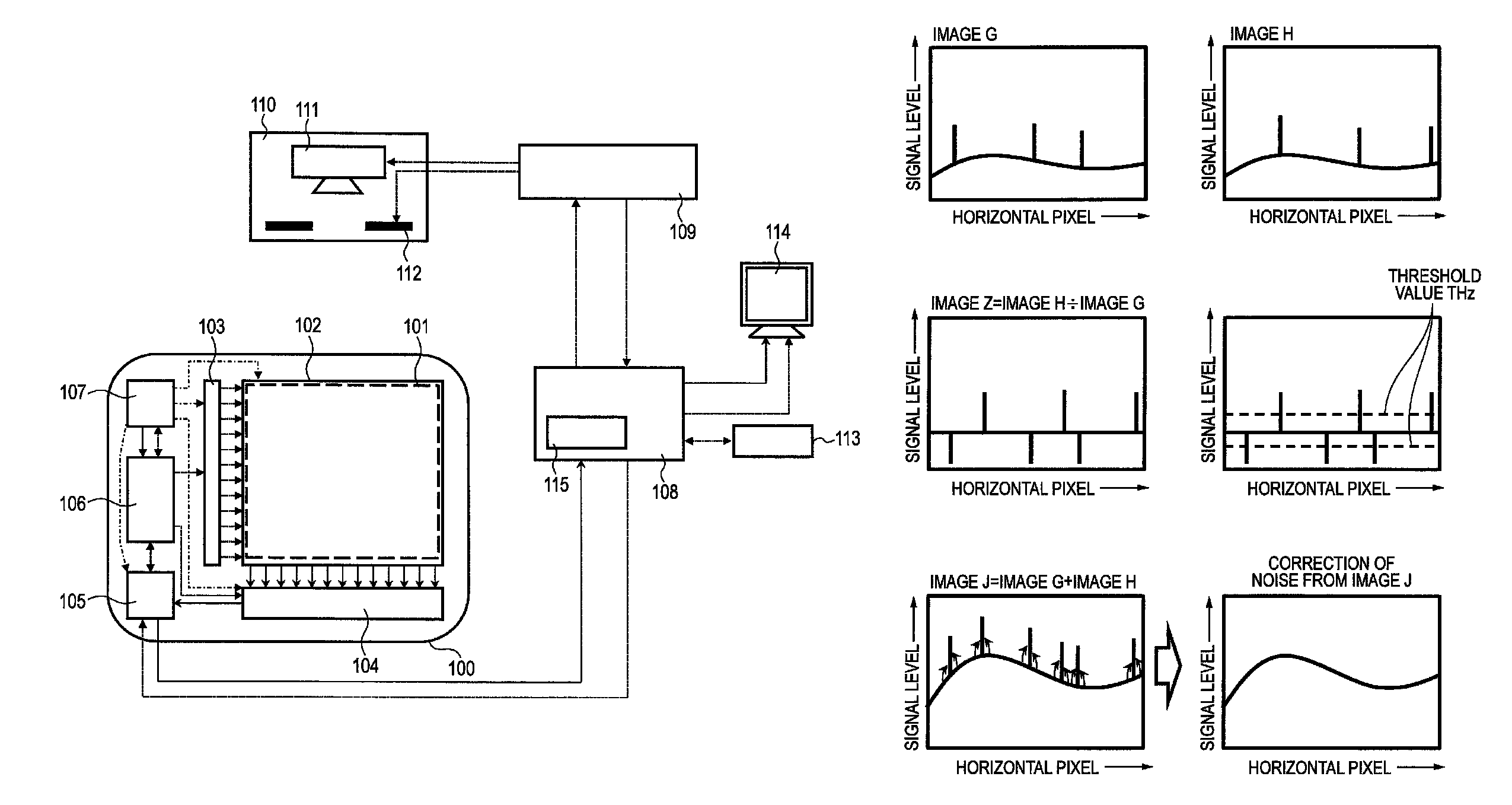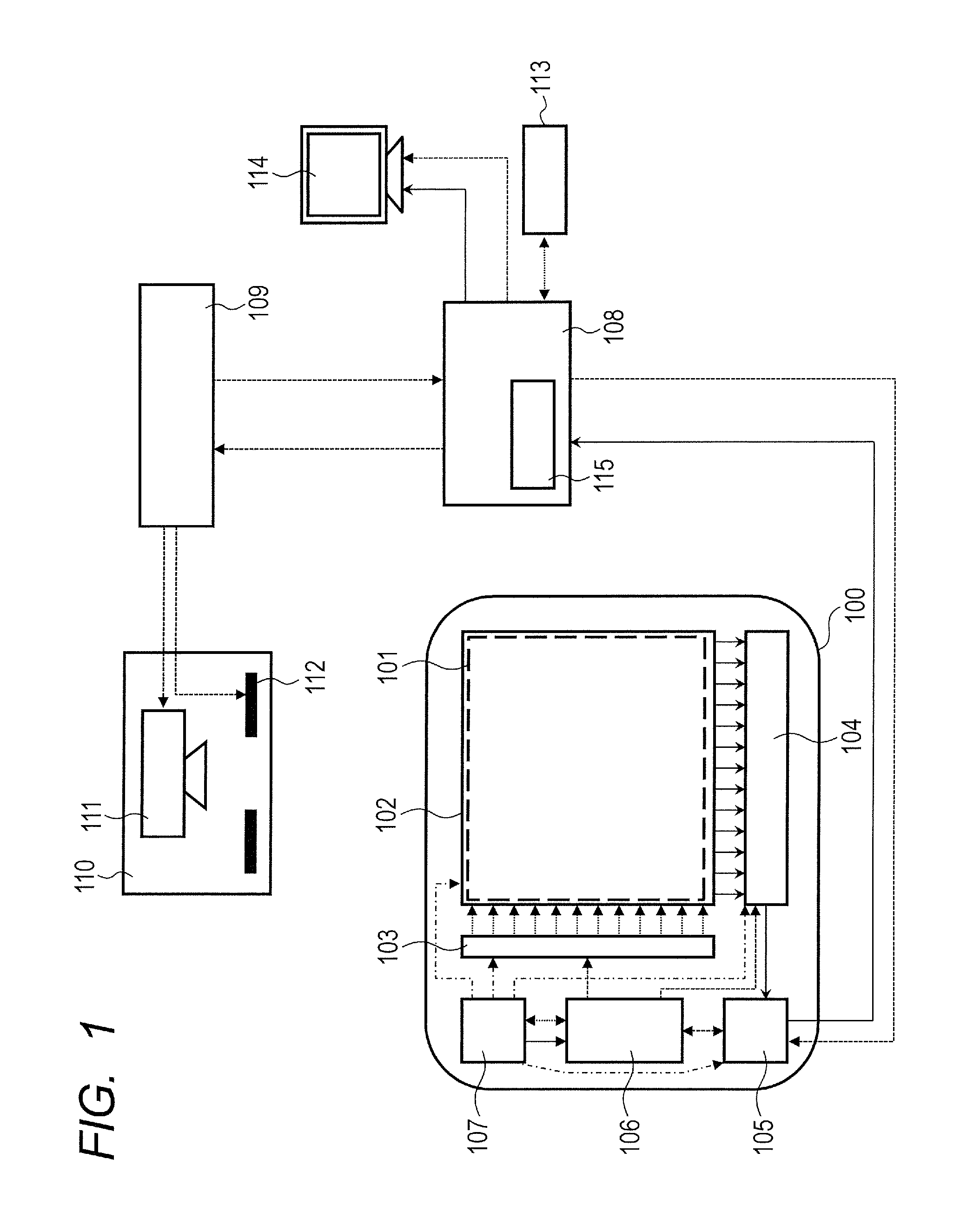Imaging system
a technology of a system and a blinker, applied in the field of imaging systems, can solve the problems of noise signal, difficult to achieve the demand particularly concerning high sensitivity and high-speed reading, and insufficient semiconductor performance of amorphous silicon, and achieve the effects of extracting and removing blinker noise, simple processing, and simple processing
- Summary
- Abstract
- Description
- Claims
- Application Information
AI Technical Summary
Benefits of technology
Problems solved by technology
Method used
Image
Examples
first embodiment
[0022]FIG. 1 is a diagram illustrating a configuration example of a radiation imaging system according to a first embodiment of the present invention. The radiation imaging system includes an imaging apparatus 100, a computer 108, a radiation control apparatus 109, a radiation generating apparatus 110, a console 113, and a display apparatus 114. The radiation generating apparatus 110 emits radiation (for example, X-rays). The imaging apparatus 100 includes a scintillator 101, an imaging element 102, a driver circuit 103, a reading circuit 104, a signal processing section 105, a control section 106, and a power supply section 107. The scintillator 101 is a conversion unit configured to convert radiation into light with a wavelength band that is detectable by the imaging element (photoelectric conversion element) 102. The imaging element 102 includes a plurality of pixels each configured to convert light converted by the scintillator 101 into an electrical signal. The driver circuit 1...
second embodiment
[0049]An imaging apparatus according to a second embodiment of the present invention has a configuration similar to that in the first embodiment illustrated in FIGS. 1, 2, and 3, and hence detailed description thereof is omitted herein. This embodiment differs from the first embodiment in that the reading operation is performed twice or more during the radiation exposure and once or more after the exposure. Thus, this embodiment refers to a processing method when three or more images are acquired.
[0050]FIG. 8 simply illustrates the reading operation when the image is read three times in a single radiation exposure. In FIG. 8, the radiation exposure period is set to t1+t2+t3, and through first reading during the radiation exposure, an image of charges generated through the radiation exposure during the period t1 is read as an image D. Next, through second reading during the radiation exposure, an image of charges generated through the radiation exposure during the period t1+t2 is rea...
third embodiment
[0056]In a third embodiment of the present invention, a method of performing reading by a method that does not leave an electrical signal inside the pixel after the reading processing, and an arithmetic processing method of a case where the reading is performed by this method are described with reference to FIGS. 10, 11, and 12. In the first embodiment (FIGS. 4 and 5), the reset transistor M1 does not reset the plurality of pixels S11 to Smn in a period after the first image A is output in accordance with the radiation during the first period t1 and before the second image b is output in accordance with the radiation during the second period t2. Further, in the second embodiment (FIG. 8), the reset transistor M1 does not reset the plurality of pixels S11 to Smn in a period after the first image D is output in accordance with the radiation during the first period t1 and before the second image F is output in accordance with the radiation during the second period t3. In contrast, in t...
PUM
 Login to View More
Login to View More Abstract
Description
Claims
Application Information
 Login to View More
Login to View More - R&D
- Intellectual Property
- Life Sciences
- Materials
- Tech Scout
- Unparalleled Data Quality
- Higher Quality Content
- 60% Fewer Hallucinations
Browse by: Latest US Patents, China's latest patents, Technical Efficacy Thesaurus, Application Domain, Technology Topic, Popular Technical Reports.
© 2025 PatSnap. All rights reserved.Legal|Privacy policy|Modern Slavery Act Transparency Statement|Sitemap|About US| Contact US: help@patsnap.com



